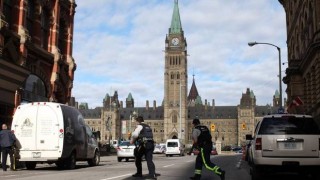Science journalist Ivan Semeniuk reviews the latest report from the Intergovernmental Panel on Climate Change, which focuses on the social effects of climate change and how societies can mitigate its effects and adapt.
Note: This lesson does not address the controversy over whether climate change is “real” and/or whether human activity is partially the cause and/or how climate change itself can or cannot be affected by changes in human activities. Based on a global consensus of scientists, which at this point must reasonably be taken as fact, this lesson assumes climate change is occurring.
Appropriate Subject Area(s):
Social studies, science, international studies
Key Question to Explore:
How can communities/societies assess and adapt to the effects of climate change?
New Terminology:
Exacerbate, mitigate, integrity, rigorous, curtail
Materials Needed:
Globe article, the Internet (for teacher only).
Introduction to lesson and task:
This lesson focuses on the effects of climate change on societies and how their specific risks and vulnerabilities can be assessed, with a view to adapting to climate change and mitigating the harmful effects. Students will read Mr. Semeniuk’s article and they will view a video on the social impact of climate change which was produced by the Intergovernmental Panel on Climate Change. They will then work in groups, using a simple model to imagine the possible effects of climate change on their own community and to suggest possible ways to mitigate and adapt to these changes.
Action (lesson plan and task):
Begin with a short discussion about climate change. You might comment on the very long and cold winter Canadians experienced this year to draw out the distinction between weather and climate. Suggested questions, prompts:
- Well, I guess this winter showed that global warming sure isn’t true. Would you agree? (answers will vary, but look for responses that focus on weather versus climate)
- What’s the difference between weather and climate? (Weather is the conditions of the atmosphere over a short period of time, whereas climate is how the atmosphere “behaves” over relatively long periods of time. Source: NASA http://www.nasa.gov/mission_pages/noaa-n/climate/climate_weather.html )
- Note that climate change is now accepted fact and we can already observe the changes, which are sometimes dramatic. Can anyone give an example? (Answers will vary, but shrinking polar icecaps, melting glaciers, rising seas and increasingly catastrophic weather events are cited by climatologists as examples of climate change in action)
- Why should we care about climate change? After all, Canada is a cold place, so wouldn’t it be better for us if it warmed up a bit? (Climate change already threatens millions of people around the globe via food shortages, water shortages, sinking island countries and so on. Because of our dependence on agriculture and because we are bordered by three oceans, rising seas are a concern. As well, the livelihood of northern Canadians is already threatened by warmer summers)
Next, show this 12-minute video, produced by the Intergovernmental Panel on Climate Change from this link to video: http://www.ipcc-wg2.gov/AR5/.
Before you play the video, tell students to pay special attention to the section where the scientist discusses risk in terms of hazard, exposure and vulnerability; as well, ensure students know the meaning of “mitigate” (to make less severe or serious) and that they note the examples of adaptation to climate change.
When the video is over provide students with the following worksheet, which they are to complete while working in groups. This is an exercise that does not require that students use the Internet, as they will be working with what they already know about their own community.
Worksheet
As a group, discuss the following questions and write down your comments and answers as you proceed.
Draw a Venn diagram (as you saw in the video) with three intersecting circles, labelled, “hazard,” “exposure,” and “vulnerability.” Record each of the effects of climate change that might affect your community in a negative way in the hazard circle; record each location or group of persons that would be most affected by this in the exposure circle; record who or what is vulnerable to this hazard in the vulnerability circle. The place where the circles intersect would tell you what the overall risk is for your community. Click here to see an example.
For example, let’s say the hazard is rising water on the shoreline; if there are no businesses, houses or people living near the water, there would be no significant exposure and no vulnerability; if they are right on the edge of the water they would be exposed. If they are houses that can be easily raised or moved, the vulnerability would be low; if the people in them are too poor to move, they would be very vulnerable.
So, based on that:
In what ways might your community be affected by global warming as an effect of climate change? Consider:
- Rising sea levels
- Hotter summers
- Less rain
- More intense storms
For each of these—and for others you can name—identify or suggest who or what could be affected in a negative way by the change and how vulnerable each is (based on their ability to adapt)
Finally, suggest some ways that these vulnerable industries or people could mitigate the effects of the change and/or adapt to it. For example, perhaps farmers could grow crops that require less rain; businesses could locate inland from the shoreline and so on.
Consolidation of Learning:
Students present and explain their Venn diagrams to the class.
Success Criteria:
Students understood the exercise, completed their Venn diagrams, presented to class.
Confirming Activity:
Evaluation of students’ diagrams.

